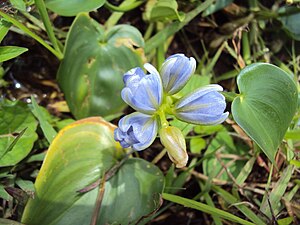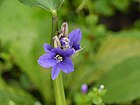Note: This is a project under development. The articles on this wiki are just being initiated and broadly incomplete. You can Help creating new pages.
Difference between revisions of "Monochoria vaginalis"
| Line 1: | Line 1: | ||
| − | + | [[File:Monochoria vaginalis 01.JPG|thumb|right|'''Monochoria vaginalis''']] | |
| + | '''Monochoria vaginalis''' is a species of flowering plant in the water hyacinth family known by several common names, including heartshape false pickerelweed and oval-leafed pondweed. | ||
==Uses== | ==Uses== | ||
| − | {{Uses|}}, {{Uses|}}, {{Uses| | + | {{Uses|Ayurvedic}}, {{Uses|Unani}}, {{Uses|folklore}}. |
==Parts Used== | ==Parts Used== | ||
| − | {{Parts Used|}}, {{Parts Used| | + | {{Parts Used|Roots}}, {{Parts Used|Leaves}}. |
==Chemical Composition== | ==Chemical Composition== | ||
| + | Monochoria vaginalis leaf and root extracts were evaluated for their antioxidant and anti-inflammatory property. Antioxidant property was estimated using 2,2′-azinobis(3-ethylbenzothiozoline-6-sulfonic acid) disodium salt +, metal ion chelating activity, ferric-reducing antioxidant power, superoxide anion radical scavenging, 2,2-diphenyl-1-picryl-hydrazyl, nitric oxide radical scavenging, phosphomolybdenum and hydrogen peroxide assays. | ||
<ref name="chemical composition"/> | <ref name="chemical composition"/> | ||
==Common names== | ==Common names== | ||
| − | {{Common names | + | {{Common names|kn=ನೀಲೋತ್ಪಲ neelotpala|ml=കാക്കപ്പോള kakkappola, കരിങ്കൂവളം karinkuvalam, കുളച്ചേമ്പ് kulachempu, കുവലയം kuvalayam|sa=इन्दिवर indivara|ta=கருங்குவளை karu-n-kuvalai|te=నీరు కాచ neerukaacha, నీరుకాంచ nirokancha|hi=ननका nanka, पानपत्ता paanpatta |en=Oval Leaf Pondweed, Oval Leaf Monochoria, Marshy betelvine}} |
==Properties== | ==Properties== | ||
Reference: Dravya - Substance, Rasa - Taste, Guna - Qualities, Veerya - Potency, Vipaka - Post-digesion effect, Karma - Pharmacological activity, Prabhava - Therepeutics. | Reference: Dravya - Substance, Rasa - Taste, Guna - Qualities, Veerya - Potency, Vipaka - Post-digesion effect, Karma - Pharmacological activity, Prabhava - Therepeutics. | ||
===Dravya=== | ===Dravya=== | ||
| + | |||
===Rasa=== | ===Rasa=== | ||
| − | |||
===Guna=== | ===Guna=== | ||
| Line 29: | Line 31: | ||
==Habit== | ==Habit== | ||
| − | {{Habit|}} | + | {{Habit|Herbs}} |
==Identification== | ==Identification== | ||
===Leaf=== | ===Leaf=== | ||
| − | {{Leaf|||}}<ref name="Leaf"/> | + | {{Leaf|Simple, heart-shaped or rounded, shiny, deep green in color|ovate-oblong to broadly ovate|Leaves variable - 2-12.5 cm long, 0.5-10 cm wide, in very young plants without lamina; leaves of somewhat older plants with a floating linear or lanceolate blade; leaves of still older plants}}<ref name="Leaf"/> |
===Flower=== | ===Flower=== | ||
| − | {{Flower||| | + | {{Flower|Bisexual||Petals six, violet or lilac blue||spreading at flowering, afterwards spirally contorted. As is typical of many aquatic annuals, plant size, leaf shape, and flower number are highly variable in relation to the amount of water. August-March}} |
| − | |||
| − | |||
| − | |||
===Other features=== | ===Other features=== | ||
| Line 46: | Line 45: | ||
==Where to get the saplings== | ==Where to get the saplings== | ||
| − | |||
==Mode of Propagation== | ==Mode of Propagation== | ||
| − | {{Propagation|}} | + | {{Propagation|Seeds}}. |
==How to plant/cultivate== | ==How to plant/cultivate== | ||
| + | A plant of the moist tropics, where it is found at elevations up to 1,500 metres. It grows best in areas where annual daytime temperatures are within the range 22 - 35°c, but can tolerate 13 - 38°c. It prefers a mean annual rainfall in the range 1,200 - 2,000mm, but tolerates 700 - 4,000mm. | ||
<ref name="How to plant/cultivate"/> | <ref name="How to plant/cultivate"/> | ||
==Commonly seen growing in areas== | ==Commonly seen growing in areas== | ||
| − | {{Commonly seen| | + | {{Commonly seen|Lowland forest}}. |
==Photo Gallery== | ==Photo Gallery== | ||
<gallery class="left" caption="" widths="140px" heights="140px"> | <gallery class="left" caption="" widths="140px" heights="140px"> | ||
| + | File:Monochoria vaginalis (3870910386).jpg | ||
| + | File:Monochoria vaginalis Blanco2.466-cropped.jpg | ||
| + | File:Monochoria vaginalis at Kadavoor.jpg | ||
</gallery> | </gallery> | ||
==References== | ==References== | ||
| + | |||
<references> | <references> | ||
| + | <ref name="chemical composition">[https://www.researchgate.net/publication/262818794_Antioxidant_and_anti-inflammatory_potential_of_Monochoria_vaginalis_Burm_F_C_Presl_A_wild_edible_plant Chemical composition]</ref> | ||
| − | <ref name=" | + | <ref name="Leaf">[http://www.flowersofindia.net/catalog/slides/Oval%20Leaf%20Pondweed.html Morphology]</ref> |
| − | |||
| − | |||
| − | <ref name="How to plant/cultivate">[ | + | <ref name="How to plant/cultivate">[http://tropical.theferns.info/viewtropical.php?id=Monochoria+vaginalis Cultivation Details]</ref> |
| − | |||
</references> | </references> | ||
==External Links== | ==External Links== | ||
| − | * [ ] | + | * [https://en.wikipedia.org/wiki/Pontederia_vaginalis Monochoria vaginalis] |
| − | + | ||
| − | + | ||
[[Category:Herbs]] | [[Category:Herbs]] | ||
| − | [[Category: | + | [[Category:Pontederiaceae]] |
Revision as of 11:24, 8 June 2020
Monochoria vaginalis is a species of flowering plant in the water hyacinth family known by several common names, including heartshape false pickerelweed and oval-leafed pondweed.
Contents
- 1 Uses
- 2 Parts Used
- 3 Chemical Composition
- 4 Common names
- 5 Properties
- 6 Habit
- 7 Identification
- 8 List of Ayurvedic medicine in which the herb is used
- 9 Where to get the saplings
- 10 Mode of Propagation
- 11 How to plant/cultivate
- 12 Commonly seen growing in areas
- 13 Photo Gallery
- 14 References
- 15 External Links
Uses
Parts Used
Chemical Composition
Monochoria vaginalis leaf and root extracts were evaluated for their antioxidant and anti-inflammatory property. Antioxidant property was estimated using 2,2′-azinobis(3-ethylbenzothiozoline-6-sulfonic acid) disodium salt +, metal ion chelating activity, ferric-reducing antioxidant power, superoxide anion radical scavenging, 2,2-diphenyl-1-picryl-hydrazyl, nitric oxide radical scavenging, phosphomolybdenum and hydrogen peroxide assays. [1]
Common names
| Language | Common name |
|---|---|
| Kannada | ನೀಲೋತ್ಪಲ neelotpala |
| Hindi | ननका nanka, पानपत्ता paanpatta |
| Malayalam | കാക്കപ്പോള kakkappola, കരിങ്കൂവളം karinkuvalam, കുളച്ചേമ്പ് kulachempu, കുവലയം kuvalayam |
| Tamil | கருங்குவளை karu-n-kuvalai |
| Telugu | నీరు కాచ neerukaacha, నీరుకాంచ nirokancha |
| Marathi | NA |
| Gujarathi | NA |
| Punjabi | NA |
| Kashmiri | NA |
| Sanskrit | इन्दिवर indivara |
| English | Oval Leaf Pondweed, Oval Leaf Monochoria, Marshy betelvine |
Properties
Reference: Dravya - Substance, Rasa - Taste, Guna - Qualities, Veerya - Potency, Vipaka - Post-digesion effect, Karma - Pharmacological activity, Prabhava - Therepeutics.
Dravya
Rasa
Guna
Veerya
Vipaka
Karma
Prabhava
Habit
Identification
Leaf
| Kind | Shape | Feature |
|---|---|---|
| Simple, heart-shaped or rounded, shiny, deep green in color | ovate-oblong to broadly ovate | Leaves variable - 2-12.5 cm long, 0.5-10 cm wide, in very young plants without lamina; leaves of somewhat older plants with a floating linear or lanceolate blade; leaves of still older plants |
Flower
| Type | Size | Color and composition | Stamen | More information |
|---|---|---|---|---|
| Bisexual | Petals six, violet or lilac blue | spreading at flowering, afterwards spirally contorted. As is typical of many aquatic annuals, plant size, leaf shape, and flower number are highly variable in relation to the amount of water. August-March |
Other features
List of Ayurvedic medicine in which the herb is used
Where to get the saplings
Mode of Propagation
How to plant/cultivate
A plant of the moist tropics, where it is found at elevations up to 1,500 metres. It grows best in areas where annual daytime temperatures are within the range 22 - 35°c, but can tolerate 13 - 38°c. It prefers a mean annual rainfall in the range 1,200 - 2,000mm, but tolerates 700 - 4,000mm. [3]
Commonly seen growing in areas
Photo Gallery
References
External Links
- Ayurvedic Herbs known to be helpful to treat Ayurvedic
- Ayurvedic Herbs known to be helpful to treat Unani
- Ayurvedic Herbs known to be helpful to treat folklore
- Herbs with Roots used in medicine
- Herbs with Leaves used in medicine
- Herbs with common name in Kannada
- Herbs with common name in Hindi
- Herbs with common name in Malayalam
- Herbs with common name in Tamil
- Herbs with common name in Telugu
- Herbs with common name in Sanskrit
- Herbs with common name in English
- Habit - Herbs
- Index of Plants which can be propagated by Seeds
- Herbs that are commonly seen in the region of Lowland forest
- Herbs
- Pontederiaceae



